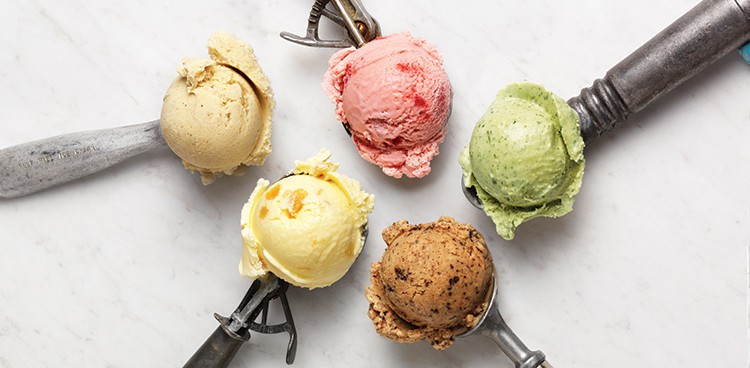
With all the tantalizing scoops and pints available these days, you might be wondering: Why bother making ice cream at home? Trust us, super-fresh spoonfuls right out of the churner just taste better. And the process is fun to boot—it feels like magic, but it’s actually chemistry. It’s not hard, but whipping up your up your own confections does require patience (no instant gratification here) and attentiveness (little details matter). But once you grasp the basic techniques, the flavor possibilities are endless. So take our step-by-step advice—gleaned from making batch after batch for our Summer 2016 issue—then take matters into your own hands. (Double chocolate with gummy bears and coffee beans? You do you!)

Bring the Flavor
Dairy provides a blank canvas for experimentation. But not all flavorings are created equal—here’s how to make the most of your additions:
SPICES OR HERBS: Steep spices, herbs, or tea in the milk or cream to infuse it with flavor. Strain, then make the custard. Pleasant hints will linger. See our recipe for Tarragon-Mint Ice Cream.
CHEESE: Curds supply tangy notes and butterfat to ice cream, so cut back the fat in your custard by swapping out some or all of the cream for milk. See our recipe for Ginger-Chèvre Ice Cream,
FRUITS: Melon, berries, and stone fruit increase the mix’s moisture content, and too much water equals icy ice cream. To counterbalance this extra H2O, dial up the fat (more cream, less milk). See our recipe for Double Raspberry Ice Cream.
BOOZE: Because alcohol freezes at a much lower temperature than water and milk, an ice cream with some added booze will have a softer texture—as well as a depth of flavor—straight out of the freezer. Pro tip: Use alcohol to keep fruit-based ice cream from freezing too hard. See our recipe for Spiced Rum Ice Cream.
MIX-INS: Toss in candy, nuts, and other bits toward the end of churning, when the mixture has firmed up. And think about texture—some additions are better when coarsely ground (chocolate chips), while others can stay chunky (cookies or brownies). See our recipe for Almond-Chip Ice Cream.

Put an Egg In It
Not all ice creams are egg-based (click here to see our glossary), but we swear by the French custard method: Slowly heat egg yolks, cream or milk, and sugar until the mixture thickens. Each of these main ingredients plays a special role in creating reliably smooth, rich, and dense homemade ice cream.
EGGS: Egg yolks are natural emulsifiers, helping to bind the other ingredients into a creamy base.
SUGAR: Sugar helps the ice crystals freeze into smaller, more flexible pieces—resulting in a smoother texture.
DAIRY: The butterfat in whole milk and heavy cream lends richness, soaks up the flavors of added ingredients, and brings a lush mouthfeel to the finished product.

Keep Things Frosty
Now it’s time to churn and freeze. The colder your ingredients and equipment (refrigerate your base and freeze your machine’s removable bowl overnight), the better the finished product (read: smoother texture). That’s because the faster ice cream freezes, the smaller the ice crystals will be, and smaller crystals mean creamier ice cream. And store the finished product in the coldest part of the freezer, too: The crystals will have less chance to melt and refreeze. (If they do, they’ll be bigger—bummer).
PHOTOS: Volosina (tarragon), Melica (blue cheese), Viktor1 (berries and chocolate), Coprid (egg), tuulijumala (snowflake) | Shutterstock; Ice Cream: photographed by Bruce Peterson, styled by Molly Shuster



